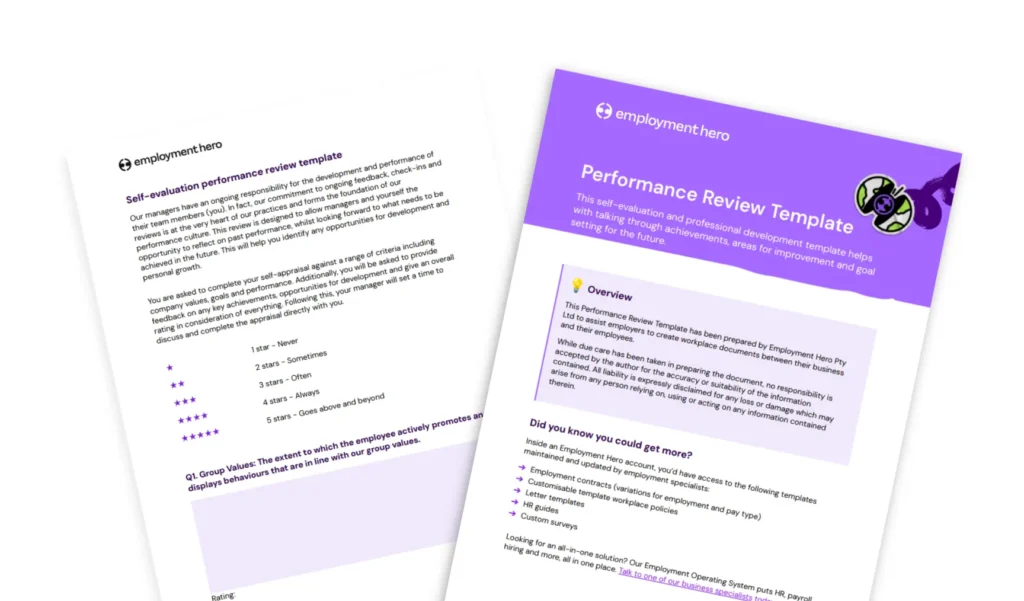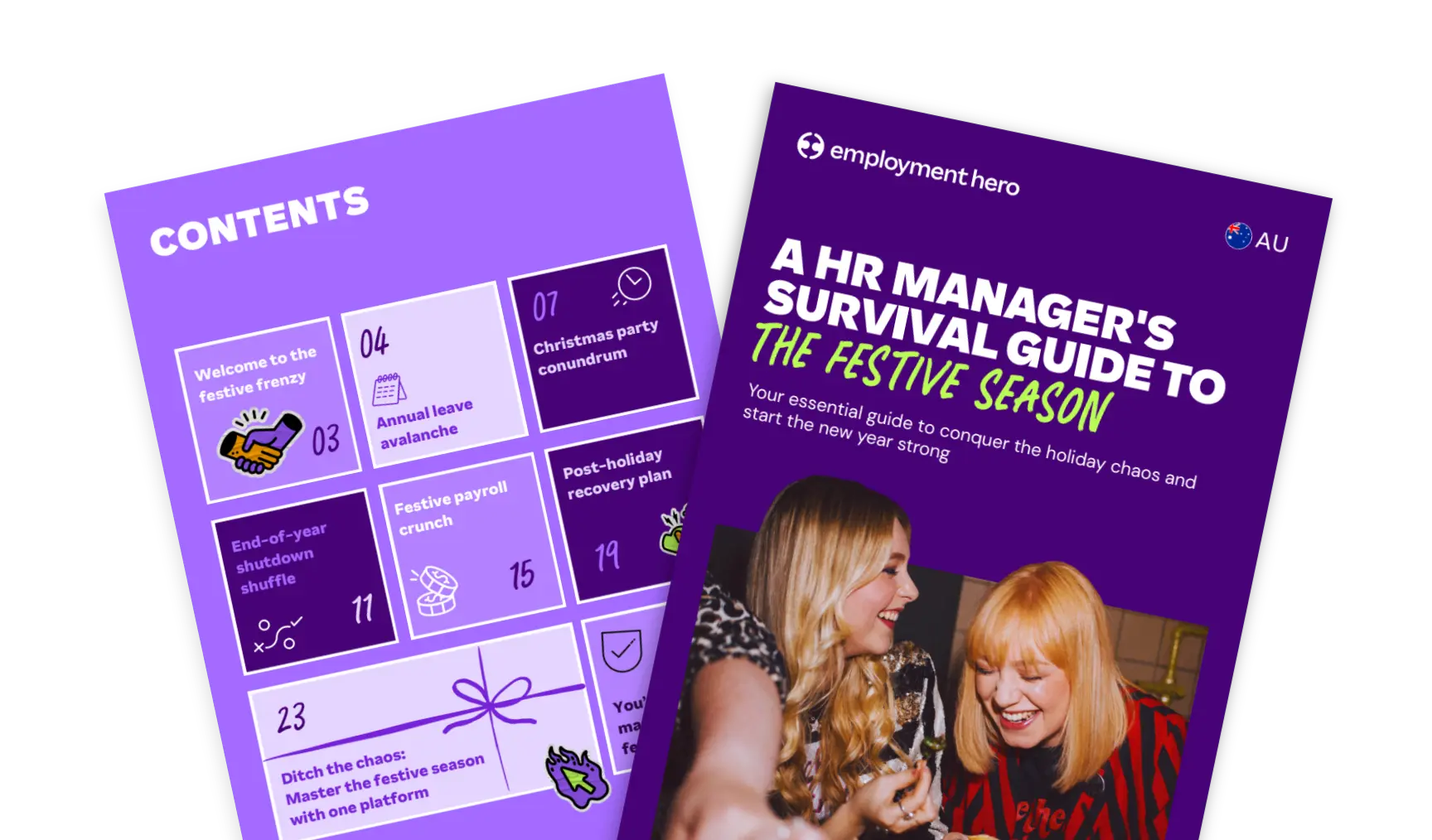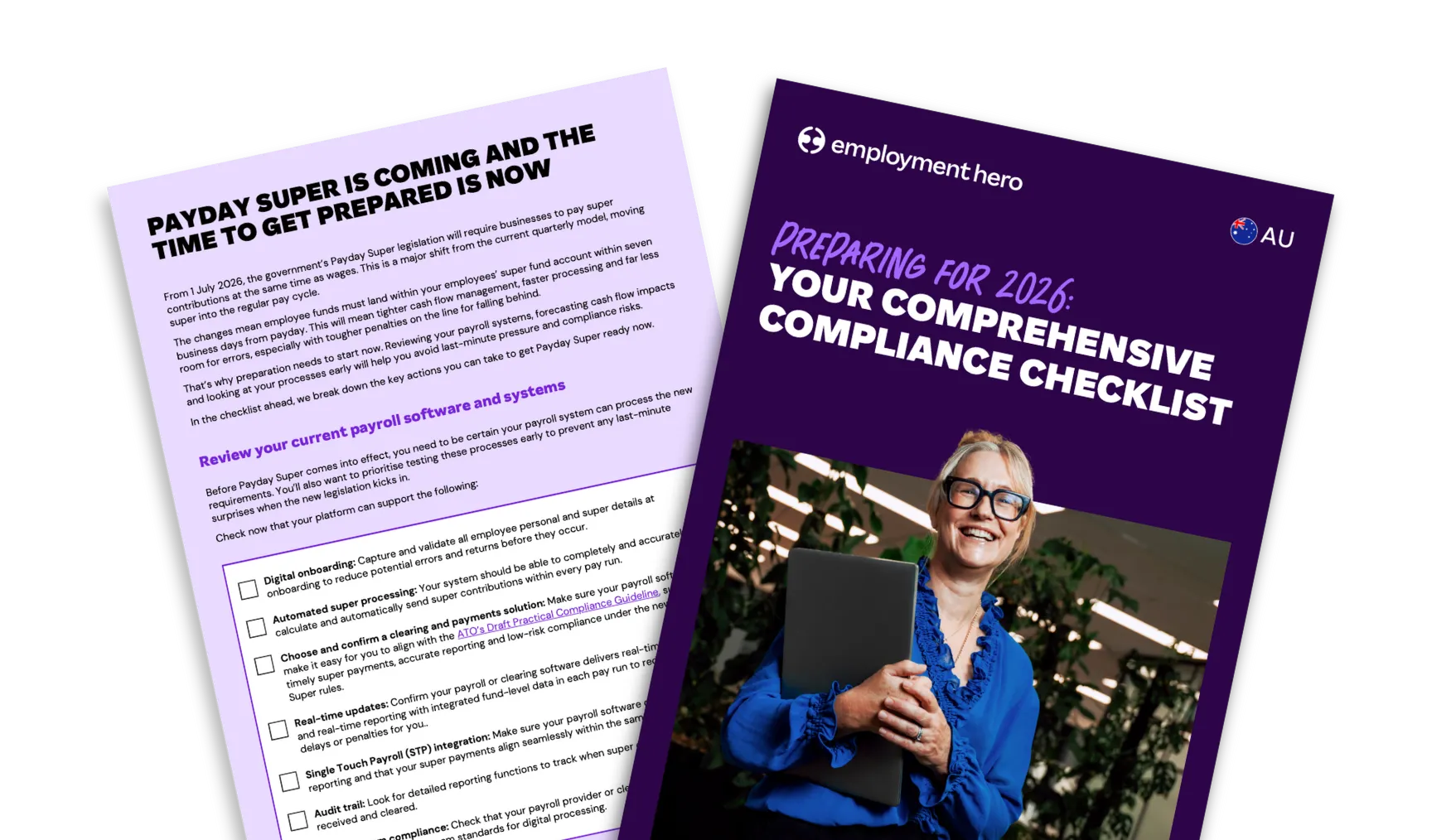Performance review template: For Australian employers
Published
Performance review template: For Australian employers
For too long, performance reviews have had a bad reputation.
In most cases, they’re seen as a box-ticking exercise that leaves everyone feeling uninspired. But what if they could be a powerful tool for growth, motivation and retention?
It’s time to ditch outdated, ineffective methods and build a structured process that actually drives results. A well-designed performance review template is your first step.
A great template provides the framework for meaningful discussions about an employee’s performance, challenges and future ambitions. It transforms the entire review process from a dreaded obligation into a genuine opportunity to align individual goals with company objectives.
This guide and template covers everything you need to know to get started.
Download the performance review template now by filling in the form.
What is a performance review template?
A performance review template can help guide and record the assessment of an employee’s performance over a specific period. Think of it as a roadmap for a productive conversation. Instead of starting from scratch every time you need to conduct performance reviews, a template provides a clear structure to follow so you can pick up where you left off.
A performance review template streamlines the employee review process by outlining key areas for discussion.
They typically include sections for evaluating achievements, identifying areas for improvement, setting future goals and discussing professional development. Having a structured approach helps managers and employees prepare for the meeting, leading to more focused and effective discussions.
Why use a performance review template?
Using a performance review template takes the grey area out of evaluations. It establishes a consistent framework that ensures every employee is assessed against the same criteria.
This structured process helps managers provide balanced feedback, highlighting both strengths and areas needing development with specific examples.

What to include in a performance review template
A performance review should facilitate a two-way conversation that empowers employees in their role, while giving managers the insights they need. A robust template, whether in Google Docs or an integrated system like Employment Hero, should capture a holistic view of an employee’s performance.
Here are the essential sections to include:
- Employee details
- Review of past goals
- Key achievements
- Areas for improvement
- Core competencies/values alignment
- Employee feedback and comments
- Future goals (follow the SMART framework for goal-setting)
- Professional development plan
- Space for additional comments
How to use your free performance review template
Once you’ve downloaded your template, you can start to transform your review process.
Here’s a practical guide for employers to get started with the performance review template.
- Share the template in advance
Give the employee the template at least a week before the review meeting. Ask them to complete the self-assessment sections. This encourages them to reflect on their own performance and prepare specific examples and discussion points.
- Manager preparation
As a manager, you should also complete your sections of the template before the meeting. Gather relevant information, review notes from 1-on-1s throughout the review period and think about concrete examples to support your feedback.
- Conduct the review meeting
Use the filled-out template as the agenda for your meeting. Walk through each section, allowing the employee to share their perspective first. The goal is a conversation, not a lecture. Discuss areas of agreement and disagreement calmly and constructively.
- Finalise and sign
After the discussion, update the template with any new goals or actions agreed upon during the meeting. Both you and the employee should sign the final document to acknowledge the conversation. Store it securely in the employee’s file, or use Employment Hero performance management tools to automate this entire workflow.
- Follow up
The performance review is just one touchpoint. Use the template to guide regular check-ins and provide continuous feedback. The goals and development plans set within it should be living documents that you refer to often.

Types of performance reviews
Performance reviews are not one-size-fits-all. Different situations call for different approaches. Choosing the right type of template makes sure that the review is appropriate for the time and achieves its intended purpose, whether it’s a deep annual dive or a quick quarterly check-in.
Annual performance review
An annual performance review is the most traditional format, providing a comprehensive, once-a-year summary of an employee’s performance. Annual reviews are ideal for formal evaluations that impact salary, bonuses or promotions.
The template is typically detailed, covering achievements, challenges, goal attainment and long-term career planning. While effective for formal record-keeping, annual reviews should be supplemented with more frequent feedback to be truly effective.
Quarterly performance review
To foster a culture of continuous improvement, many businesses are moving to a quarterly review cycle. These are more concise than annual ones, focusing on progress towards annual goals and setting short-term objectives for the next 90 days. Quarterly reviews make the feedback loop shorter, allowing for quicker course correction and alignment with business priorities.
Manager performance review
Feedback should be a two-way street. A manager performance review template allows direct reports to provide anonymous or direct feedback on their manager’s effectiveness. This type of review assesses leadership skills, communication, support and management style. It’s a powerful tool for developing stronger leaders and improving team dynamics.
Self-performance review template
This template is for the employee. It prompts them to reflect on their accomplishments, challenges and contributions before the formal review meeting. A self-performance review empowers employees to take an active role in their evaluation and career development.
It provides managers with valuable insights into the employee’s perspective, highlighting any gaps in perception and setting the stage for a more collaborative discussion.
360-degree performance review
A 360-degree review offers the most holistic view of an employee’s performance by gathering feedback from multiple sources including peers, direct reports and managers. This template is designed to collect diverse perspectives on an employee’s skills, behaviours, and impact. It’s invaluable for leadership development and identifying blind spots in an individual’s own performance assessment.
Download the template today and transform your entire performance review process.

How to conduct a performance review: step-by-step guide
A successful employee performance review depends on a well-executed process. Following a clear set of steps ensures the review is fair, productive and motivating for everyone involved.
Step 1: Preparation is everything
Before the meeting, both the manager and the employee must prepare. The manager should review the employee’s job description, past reviews and notes from the review period. The employee should complete their self-assessment. Both should come ready to discuss specific examples of successes and challenges.
Step 2: The review discussion
Create a comfortable and private setting for the meeting. Start on a positive note, but be direct. Use the template to guide the conversation, beginning with the employee’s self-assessment. Listen actively and ask open-ended questions to understand their perspective. The goal is to facilitate a dialogue, not dominate the conversation.
Step 3: Follow-Up and Action
The review process doesn’t end when the meeting does. Document the key discussion points and agreed-upon goals in the template. Schedule regular check-ins to monitor the employee’s progress and provide ongoing support. Following up demonstrates that you are invested in their professional development and committed to helping them succeed.
Writing effective performance review comments
The language you use matters. Vague or generic comments are unhelpful, so you want to ensure your feedback is specific, balanced and actionable.
Positive feedback
When giving praise, be specific. Instead of “Good job this year,” try something like “Your work on the Q3 marketing campaign directly led to a 15% increase in leads. Your innovative approach was a key factor in its success.”
Constructive feedback
When addressing areas for improvement, focus on behaviour, not personality. Instead of “You’re not a team player,” say “I’ve noticed in team meetings that you sometimes hesitate to share your ideas. We value your input, and I’d like to see you contribute more during our brainstorming sessions.”
Actionable feedback
Ensure your feedback gives the employee a clear path forward.
For example, “To improve your project management skills, let’s enrol you in the upcoming PMP certification course and have you shadow Sarah on the next major project.”
Setting SMART goals in performance reviews
Goals give employees purpose and direction. The SMART framework is a simple yet powerful tool to ensure that the objectives you set during a review are effective.
- Specific: Goals should be clear and unambiguous. What needs to be accomplished?
- Measurable: How will you measure success? Define concrete metrics to track progress.
- Achievable: The goal should be challenging, but realistic. Is it within the employee’s capacity to achieve?
- Relevant: Does the goal align with the employee’s role and the company’s broader objectives?
- Time-bound: Set a clear deadline. When does this goal need to be completed?
An example of a SMART goal could be: “Increase your new business sales revenue by 15% (from $50k to $57.5k) by the end of Q4 by generating and qualifying 10 new leads per week.”
Common performance review mistakes to avoid
Even with the best intentions, it’s easy to fall into common traps that can derail an employee performance review. Being aware of these pitfalls is the first step to avoiding them.
- Recency bias: Focusing only on recent events, good or bad, instead of the entire review period. Keep notes throughout the year to ensure a balanced assessment.
- Being too vague: Providing generic feedback like “You need to be more proactive.” This is not actionable. Use specific examples.
- Making it a one-way conversation: The review should be a dialogue. If the manager does all the talking, the employee will feel disengaged.
- Surprise criticisms: A formal review should never be the first time an employee hears about a significant performance issue. Provide continuous feedback throughout the year using tools in our 1-on-1s bundle.
- Inconsistency: Applying different standards to different employees. A structured process and a good template help ensure fairness for everyone.
Performance review template example
Take a quick look at what you’ll find inside our performance review template.

Download the performance review template today by filling out the form on the right.
How to give constructive feedback in performance reviews
Delivering constructive feedback is one of the most challenging parts of a manager’s job. The key is to be supportive and focus on future improvement, not past mistakes. A helpful model is the Situation-Behavior-Impact (SBI) framework.
Situation: Describe the specific context. “During the client presentation last Tuesday…”
Behavior: State the observable action. “…when you were asked about the budget, you weren’t able to provide the exact figures.”
Impact: Explain the consequences. “…this impacted our credibility and meant we had to follow up later, delaying the decision.”
Then, pivot to the future: “Moving forward, let’s ensure you have all the key data points summarised before client meetings. How can I help you prepare for the next one?” This approach keeps the feedback objective and collaborative.
For more guidance, check out our performance review guide.
Legal requirements for performance reviews in Australia
While there’s no law in Australia that mandates employers must conduct performance reviews, they’re a critical component of good employment practices and managing performance.
Proper documentation from a structured review process can be essential if you need to take disciplinary action or implement a performance improvement plan (PIP). These records demonstrate that you have given the employee clear feedback and an opportunity to improve.
Failing to follow a fair and documented process can expose your business to risks of unfair dismissal claims. Therefore, while not legally required, a consistent and well-documented employee review process is a non-negotiable best practice for any Australian business.
Download your performance evaluation template
Ready to build a high-performing team? Stop treating performance reviews as a chore and start using them as the strategic tool they are.
Our free templates provide the structure you need to have meaningful conversations, set clear goals and invest in your employees’ professional development.
Download the template today and transform your entire performance review process.
Access your free templates below
Related Resources
-
 Read more: HR Managers: Don’t just survive the festive season, master it
Read more: HR Managers: Don’t just survive the festive season, master itHR Managers: Don’t just survive the festive season, master it
Make year-end easier: manage leave, payroll, parties and shutdowns with confidence. Get practical tips for Australian SMEs. Download the free…
-
 Read more: Preparing for 2026: Your Compliance Checklist
Read more: Preparing for 2026: Your Compliance ChecklistPreparing for 2026: Your Compliance Checklist
Get your business ready for the 1 July 2026 changes. See practical steps for Payday Super, cash flow planning and…
-
 Read more: Monthly business budget template for employers
Read more: Monthly business budget template for employersMonthly business budget template for employers
Plan your monthly income and expenses with our free monthly business budget template. Download today to track cash flow and…























